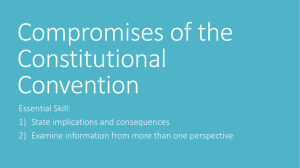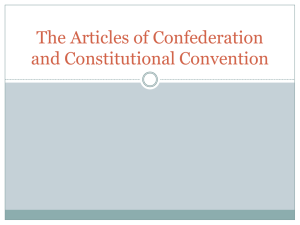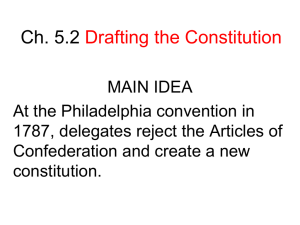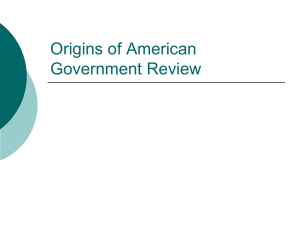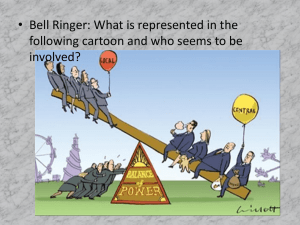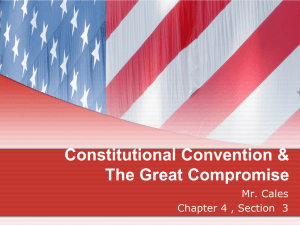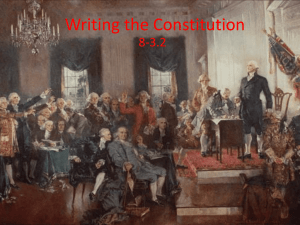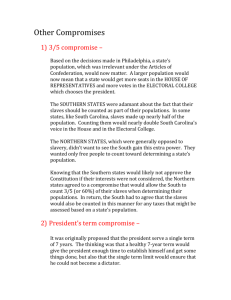Articles of Confederation and the Constitution
advertisement
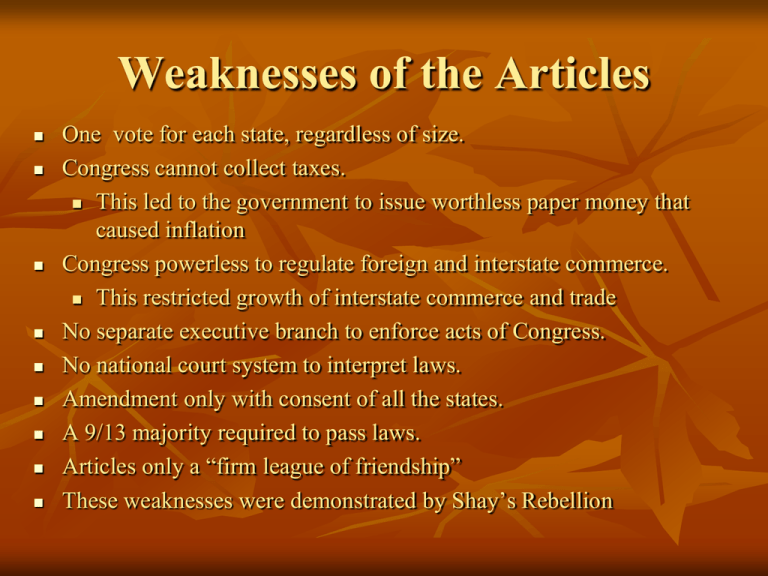
Weaknesses of the Articles One vote for each state, regardless of size. Congress cannot collect taxes. This led to the government to issue worthless paper money that caused inflation Congress powerless to regulate foreign and interstate commerce. This restricted growth of interstate commerce and trade No separate executive branch to enforce acts of Congress. No national court system to interpret laws. Amendment only with consent of all the states. A 9/13 majority required to pass laws. Articles only a “firm league of friendship” These weaknesses were demonstrated by Shay’s Rebellion Causes of Shay’s Rebellion The wealthy investors that had paid for the Revolution wanted their money back. The states raised taxes to pay the debt. Poor farmers rioted in protest of the raised taxes. Massachusetts didn’t have the money to raise an army to stop the riots. Congress didn’t have the power to tax to raise a national army to stop the riot. Effects of Shay’s Rebellion People would defy any government that acted against their wishes. It showed America that the federal government had to be strengthened to avoid civil unrest. Shay’s Rebellion was a reflection of A. B. C. D. A strong central government A weak central government An effective government A fair system of taxation What contributed to the demise of the Articles of Confederation? A. B. C. D. The lack of representation in Congress The inability of Congress to tax The ability to make treaties with foreign governments The restrictions on debate within Congress Which of these was a major domestic problem faced by the government under the Articles of Confederation? A. B. C. D. Maintaining national security Counting population for voting purposes Regulating the slave trade Establishing strong state governments Which of the following people would have MOST LIKELY supported the Articles of Confederation? A. B. C. D. A Federalist Someone who believed states, rather than a central government, should have greater authority to rule Someone who believed a central government, rather than states, should have greater authority to rule. Alexander Hamilton B The Constitutional Convention 55 Delegates meet in Philadelphia in 1787 These are mostly wealthy, all white males George Washington was elected as the presiding officer The sole purpose of the convention was to amend the Articles of Confederation Hamilton and Madison quickly directed the convention toward drafting a new document Two different plans are put forth for the new government. The Virginia Plan It called for the creation of a bicameral national legislature where each state would send representatives in proportion to the population. This plan made the federal government stronger than the state governments. The New Jersey Plan It called for the creation of a unicameral national legislature where each state had an equal number of votes This plan kept the national government weak and the states powerful. The Great Compromise It created a bicameral legislature. The Senate would have the same number of representatives from each state. In the House of Representatives, the number of representatives would be based upon the population of the state. The Federalists The Federalists were a group that advocated for increased power for the Federal government This group included Washington, Madison, Franklin and Hamilton They felt that central government would provide stability and order They were convinced that the Constitution would provide safeguards for the rights of the people The Anti-Federalists The Anti-Federalists were very leery of federal power They feared that the central government would trample the rights of the people They also felt that the federal power would usurp the power of states They insisted on a written guarantee of rights and liberties which became known as the bill of rights After the convention, Jefferson became the leading advocate for the Anti-Federalists James Madison commented that, “A government composed of such extensive powers should be well organized and balanced.” Which of the following helped to balance power between the large and small states? A. B. C. D. The slave trade The Great Compromise The three-fifths compromise The Bill of Rights The US Constitution begins with the words “We the People.” Why did Madison chose these three words to open the document? A. B. C. D. To show the delegates were unanimous in their approval of the document To show that government gets it power from the “consent of the governed” To illustrate that the Constitution was written for everyone To emphasize that the people elect everyone in government Which of the following problems did the Great Compromise solve? A. B. C. D. Slavery in the US following the revolution How many representatives each state would have in the federal legislative branch Debate over when the slave trade would end What rights would be protected under the Constitution The Three-Fifths Compromise A. B. C. D. Established a legislative branch comprised of two houses. Allowed slaves to be partially counted as part of the US population. Made George Washington president in exchange for maintaining slavery in the South. Allowed southerners to count slaves in the population in exchange for immediately ending the slave trade. Who of the following would have been MOST LIKELY to favor the Virginia Plan? A. B. C. D. A delegate to the Constitutional Convention from a small state. A delegate to the Second Continental Congress from a small state. People opposed to slavery. Delegates to the Constitutional Convention from a large state. A strong Federalist would have MOST LIKELY supported which of the following? A. B. C. D. The Jeffersonian-Republicans The Articles of Confederation The Bill of Rights The Constitution prior to any amendments C Trade and Powers The powers of government were to be divided between the state and federal governments This is a system known as federalism The Presidential term was limited to 4 years, with no limit on the number of terms The following page discusses the separation of powers and the system of checks and Balances Division of Power Slavery Issues Slaves as population Northerners do not want slaves counted, people = votes Clearly, Southerners prefer to count slaves as population 3/5ths Compromise solves the issue Importation To woo Southern states slave import is guaranteed until 1808 It is then to be regulated by Congress Lawmakers have tried to pass this campaign finance law twice. Both times, the president has vetoed the law. This time, most believe the US Supreme Court would uphold the law if it came before the Court. What does this information describe? A. B. C. D. The power of the Great Compromise The importance of federalism The system of checks and balances The need to reform government The US Constitution is built on all of the following principles EXCEPT A. B. C. D. Governments can act without answering to the people The power of the government rests with the people State and federal governments share power The federal government holds supreme power The three-fifths compromise sought to prevent A. B. C. D. States with high slave populations from dominating the House of Representatives. The Senate from becoming too powerful within the bicameral system. The Constitution from ultimately being ratified. Antifederalists from winning the debate over federalism. Limited government, a system of checks and balances, a separation of the powers in government, and government based on the will of the people, form the foundation for the A. B. C. D. Northwest Ordinance United States Constitution Louisiana Purchase Articles of Confederation


